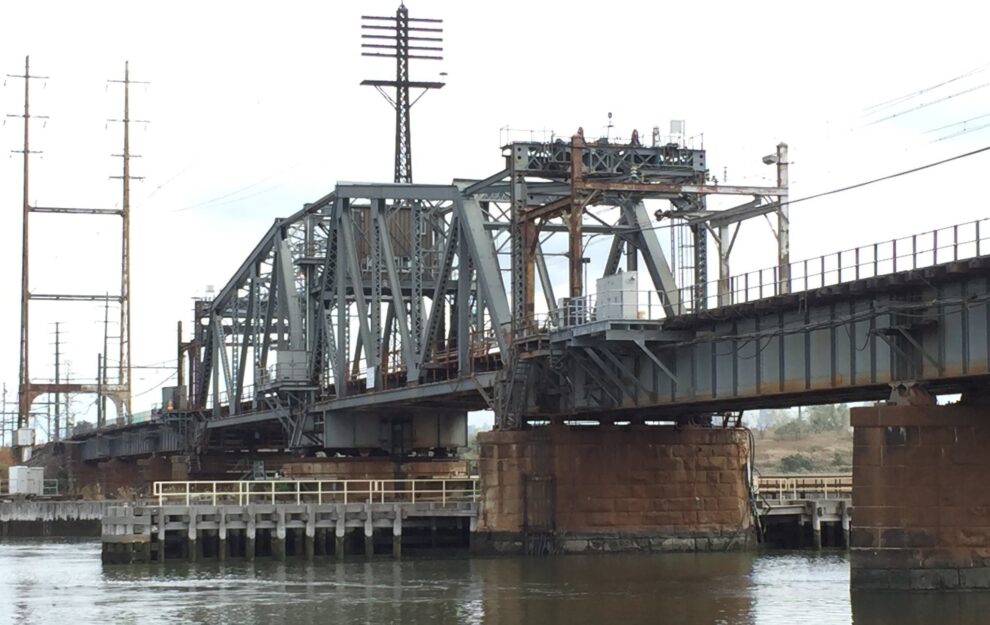New Jersey’s new $2.1 billion rail bridge across the Hackensack River is on its way to smoothing connections to New York City for hundreds of thousands of commuters and Amtrak riders when the span opens in 2026.
The Portal North Bridge also looks set to send hundreds of sewage-filled trucks onto local roads because the area’s lone commercial river operator, a barge hauling 1.2 million gallons of sludge to a treatment plant in Newark, N.J., won’t be able to navigate under the site.
Capt. Mike Vinik said the 50-feet-tall new span will be too low for his vessel, leaving trucks as the only option to transport the human waste.
“If they had just made it 55 feet, or even 52 feet, I would have been ecstatic,” Vinik said.
The conflict between the trains crossing over the bridge and the single, sewage-laden barge traveling underneath, highlights how the intertwining transport needs around New York City are creating conflicts and sharply curtailing commercial traffic on the waterway.
Shipping veterans blame the river’s bridges for choking off traffic. Boats now must run a gantlet of a half-dozen movable spans, including the Lower Hack and Upper Hack lift bridges and the HX Draw, also known as ”The Jack-Knife.”
The new Portal North Bridge, which will replace an aging swing bridge, is part of an ambitious regional effort called the Gateway Program that aims to double rail capacity along a 10-mile stretch of track between New York and New Jersey. Overseen by those two states and the Amtrak national passenger railroad, the plan includes several new bridges and a rail tunnel under the Hudson River that are set to cost tens of billions of dollars.
The program, with its high stakes and heavy costs, has been subject to fierce political battles in Washington, holding up work on the tunnel and bridge for years.
The Portal North Bridge hasn’t been as controversial for New Jersey commuters. NJ Transit is building the fixed-span crossing to replace a century-old swing bridge that carries one of the busiest rail lines in the country over the river and that is a regular cause of delays.
About 450 trains rattle over the Portal Bridge each day, traveling to and from New York City. The bridge, which stands 23 feet above the water, swings open to allow boats to pass through. But it malfunctions so often that authorities limit the openings to mitigate rush-hour train delays.
The new bridge is slated to be twice as high, eliminating the need to swing the structure open to allow boats to pass.
But the bridge is still too low for the barge carrying sludge once a week from a site in Bergen County, N.J. “My tugboat is 49 feet, so at high tide I won’t get under it,” said Vinik.
Planning for the Portal North Bridge has been under way since 2006. The U.S. Coast Guard concluded in 2013 that the new bridge wouldn’t disturb river traffic, and work on the span began last year.
Representatives for NJ Transit and Amtrak said in a joint statement that the planning process “included a robust public outreach and engagement effort.”
Scheduling an opening of the movable bridges along the river has become more difficult in recent years, said Terry DeMeo, Chair of the Towboat and Harbor Carriers Association of New York and New Jersey. “If you have one or two bridge openings delayed you can spend an entire day waiting to get through the Hackensack River,” she said.
A single barge holds the equivalent of hundreds of tanker trucks’ worth of sludge. This summer, when the bridge was closed after workers accidentally cut a communications cable, the Bergen County Utilities Authority had to fill 50 trucks each day, six days a week, to ship the waste on a 30-mile round-trip from Little Ferry, N.J., to the Passaic Valley Sewerage Commission in Newark.
“The inability to barge the sludge creates great unpredictability and forces us to rely upon trucking at an increased cost,” said Robert Laux, the authority’s executive director.
Vinik and the Towboat and Harbor Carriers Association of New York and New Jersey say they first heard about the bridge plans in July 2022. Vinik says he realizes now it is too late to change the bridge design. He has considered changing his tugboat by installing hinges on the mast and antennas, but he said that could cost more than $250,000.
“We are most probably going to have to buy a smaller tugboat,” he said.
Source: MSN












Add Comment